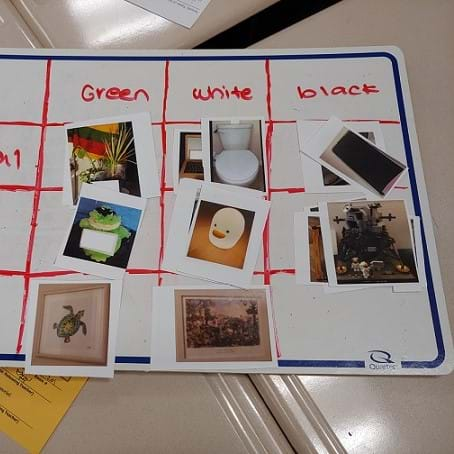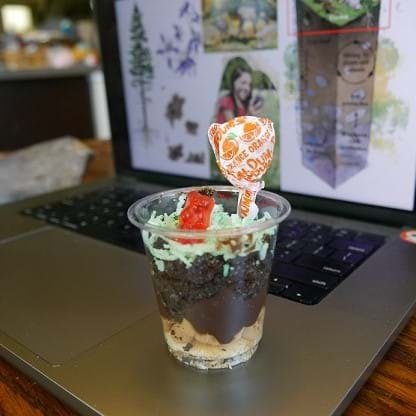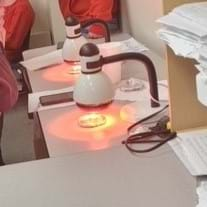
Engineering a Ping Pong Ball Retriever Middle School Activity
Published on April 17, 2024
Students use the engineering design process while learning about accessibility for people with physical disabilities in Egypt. Students are challenged to create a reusable prototype to help a wheelchair table tennis team pick up ping pong balls. Before building their prototypes, students research the trash and waste problem in Egypt, compiling a list of sustainable materials that can be used to build their devices. Students then individually brainstorm and plan at least two different devices before coming together in teams to develop one group prototype design. After building, testing, and improving their prototypes, student groups present their prototypes to the class.
Let it Flow! Fluid Viscosity & Temperature High School Activity
Published on April 17, 2024
Students use a hot plate, ice-water bath, and common lab equipment to prepare a viscous or semi-viscous liquid at cold, room, and warm temperature levels. Students measure the mass, volume, and density of their specific liquid to determine the viscosity of their liquid at different temperatures. Students compare their liquid to another group’s liquid to compare and determine any trends with temperature and viscosity.
Insulator Design Challenge Middle School Activity
Published on April 4, 2024
Students engage in the engineering design process while identifying the relative thermal conductivity of different materials. Students apply their understanding of heat transfer to build an insulator to prevent heat loss or gain from an object. Students practice the engineering design process by building their insulator. At the end, they reflect on the design process and the effectiveness of their product.
What’s Your Angle? Assessing Wave Refractions High School Activity
Published on March 22, 2024
Students observe wave refraction in different mediums. They trace the path of light waves of a laser entering a medium and exiting the medium. Then they measure the angle of the refracted ray using a protractor to get an understanding of the concepts of how refraction works in different mediums. By the end of the lesson, students will be able to identify which substance refracted light the most and hypothesize a pattern of refraction based on the densities of the substance.
Creative Engineering Design: Model EV Design Challenge High School Activity
Published on March 19, 2024
Students collaborate creatively in teams (2-4 students) to design, build, test, and iterate a model electric vehicle (EV) car that runs on a battery-powered electric motor circuit. Students apply and integrate the engineering design process, forms of energy (electrical, chemical, mechanical), and related physics concepts, such as simple machines (pulleys, axles and wheels), complex machines (gears), and motion of objects (friction, speed) to maximize the performance of their model EV. Throughout this project-based engineering design challenge, students learn about EV-related environmental justice concepts, including air quality, health, environmental and transportation connections. In a final design expo, teams have the opportunity to present about their final EV model, their design process journey, and their perspectives on the intersection of engineering and environmental justice in regard to EVs. Teams can also participate in fun model EV race and aesthetic design competitions.
Robo-mentum: Mass, Velocity, and Momentum Relationships High School Activity
Published on March 19, 2024
Student groups use STEM vehicle kits to learn about the relationships between linear momentum, mass, and velocity. Each group assembles their vehicle and then runs tests and gathers data to calculate their vehicle’s velocity/speed and linear momentum. This data is then used to create scatter plots of the three variables (linear momentum, mass, and velocity/speed), and the Desmos graphing calculator is used to model a direct relationship using linear regression, as well as model an inverse relationship using exponential regression.
Exploring Light With Holographic Chocolate Middle School Activity
Published on March 8, 2024
Students explore how light interacts with matter. Using the principles of spectroscopy, they learn how light can cause molecules to react by entering into an excited state. This activity addresses diffraction grating, which is in a spectrometer (a specialized instrument used to track and measure the path of different wavelengths of light). This instrument is used in many applications that study light-matter interactions. Students apply a diffraction grating to chocolate, allowing them to observe the ray of light being separated into different colors and wavelengths and how light can interact differently with common materials by altering their properties. Students further explore light by designing light-powered products and presenting their designs to the class.
Ready, Set, Solar! Design a Solar Powered Car Elementary School Activity
Published on March 7, 2024
Students learn that solar energy is a renewable energy source from the sun that can be collected and used to power different items, and that solar panels allow us to gather this energy in one place and use it as electricity. As a renewable resource, the sun provides a clean and abundant source of energy that can help reduce pollution and harm to the environment. To model this process, students use a solar powered rover kit to make a car out of recycled materials. In groups of two, students use the Engineering Design Process (EDP) and follow each of the steps to complete, test, redesign, and retest their cars. Students test their car in the sun with the panel at two different angles and then once in the shade. What worked best? Then the race is on!
A Slippery Situation: Oil Spill Cleanup and Polarity Middle School Activity
Published on March 7, 2024
Students learn about the concept of polarity and mixing through the phenomenon of oil separating from water by simulating an oil spill that demonstrates the impact of these molecular qualities on the environment. In the first part of the activity, students get familiar with the concept of polarity and how it causes oil to float on water through molecular models and demonstrations. The second part entails a simulation of an oil spill in the ocean, where students are given a variety of tools and will engineer their own solutions to clean up the spill through trial and testing. Finally, they discuss the real-world methods used to clean up oil spills, and their impact on the environment.
Creative Engineering Design: Tinkercad Circuits & EV Motor Workshop High School Activity
Published on February 29, 2024
Students follow a guided engineering skills workshop presentation using the free online Tinkercad web app learning the basics about circuits, using a simulator to create circuits, and applying these skills to build a model EV electric motor. Tinkercad offers students an opportunity to build their circuit and electronics skills. Teachers can create and manage classes, activities, etc. in Tinkercad to enable students to explore circuits in both in-school and online learning environments.
Creative Engineering Design: Tinkercad 3D Design & EV Concept Car Workshop High School Activity
Published on December 6, 2023
Students follow a guided engineering skills workshop presentation using the free online Tinkercad web app to design a model 3D EV concept car design. Tinkercad offers students an introduction to learning basic computer-aided design (CAD) skills. Teachers can create and manage classes, activities, etc. in Tinkercad to enable students to explore CAD in both in-school and online learning environments.
Creative Engineering Design: Environmental Justice StoryMap Collection High School Activity
Published on December 5, 2023
The series of five Environmental Justice (EJ) StoryMaps explores the connections between air quality, transportation, and engineering. The EJ StoryMap collection provides background knowledge from reliable sources to build students’ understanding of concepts presented in a visual and interactive format.

Periodic Table Intro: Parts of a Whole High School Activity
Published on October 4, 2023
The Periodic Table is an icon of organizing for chemistry as well as other disciplines including chemical engineering. The table also represents an important way to understand how to sort and identify objects based on specific criteria. In this activity, students submit a picture of a unique “one-of-a-kind” item they own. They then create diagrams that sort these various items based on categories of their choosing. They discuss the process as a class, drawing upon similarities to the creation of the Periodic Table: identifying individual characteristics of an object/element, and sorting objects/elements into rows and columns based on similar characteristics.

Exploring the Earth’s Critical Zone with Edible Model Cross Sections Elementary School Activity
Published on September 28, 2023
The Critical Zone is the layer of the Earth that extends from bedrock to treetops. It is within this layer that rock, soil, water, air, and living organisms interact and shape the Earth's surface. It is also here where all known life on Earth exists! In this activity, students learn about and explore the critical zone by creating their own cross-section out of food treats.

Heat Transfer in Solar Dryers High School Activity
Published on September 27, 2023
Understanding the concepts of conduction, convection and radiation help engineers design and build systems that employ the process of heat transfer. In this activity, students use a hair dryer, hot plate and a heat lamp to show the three types of heat transfer and how these processes can be used in agricultural engineering applications. They compare the time it takes for each process and, as they learn about these processes, students delve deeper into why there are time differences for each.
